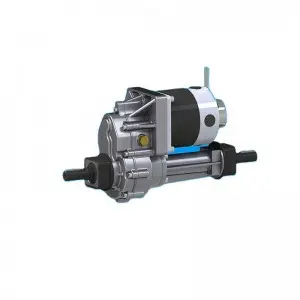The automotive industry is full of technical terms such as engine, transmission, differential, and more. Another important component that may not be as well known among non-enthusiasts is the transaxle. In this blog post, we’ll explore what a transaxle is, what it does, and why it plays an important role in modern vehicles. So, let’s dive into the exciting world of transaxles!
What does a transaxle do?
The transaxle is an important component found in most modern front-wheel drive and all-wheel drive vehicles. It acts as a combined transmission and differential unit responsible for transferring power from the engine to the wheels. In short, it helps the engine and wheels work together smoothly, ensuring optimum performance and efficiency.
Function of the transaxle:
1. Power Distribution: The transaxle efficiently distributes power from the engine to the wheels. In a front wheel drive (FWD) vehicle, the transaxle is located at the front end, combining the transmission, differential and final drive into a single unit. It receives rotational power from the engine, uses gears to alter torque transmission, and sends it to the front wheels.
2. Gear Shifting: The transaxle facilitates gear shifting, allowing the driver to select the necessary gear ratio based on the vehicle’s speed and desired performance. With a complex system of gears, the transaxle ensures smooth acceleration, deceleration and the overall driving experience.
3. Torque modulation: Modern transaxles not only distribute power, but also regulate torque between the wheels. In an all-wheel-drive (AWD) vehicle, a transaxle can send different amounts of torque to each wheel depending on traction conditions. This enhances stability, handling and improves safety on a variety of terrains.
4. Mechanical Advantage: A transaxle utilizes a specific gear configuration to provide a mechanical advantage to the vehicle. Transaxle ratios can be optimized to provide high torque for hill climbing, quick acceleration or fuel efficiency during highway cruising. These mechanical advantages are critical to maintaining optimal vehicle performance under varying driving conditions.
Why is a transaxle important?
Having a transaxle in a modern vehicle brings several benefits to the driver and the vehicle itself:
1. Space optimization: Combining the gearbox and differential into one unit (transaxle) can help manufacturers save space. This design is often used in front-wheel drive vehicles, where the powertrain needs to fit in a limited area.
2. Improved fuel efficiency: The transaxle’s ability to optimize gear ratios contributes to better fuel efficiency. It ensures that the engine runs within its optimum operating range, reducing unnecessary stress and excessive fuel consumption.
3. Enhanced vehicle dynamics: The transaxle provides torque modulation and plays a vital role in maintaining vehicle stability and control. This is especially true in all-wheel-drive vehicles, where the transaxle can dynamically adjust torque distribution, enhancing traction and overall handling in challenging conditions.
in conclusion:
While many drivers may not know what a transaxle is or what it does in a vehicle, understanding its function and importance can provide an understanding of its vital role. The transaxle bridges the gap between the engine and the wheels, distributing power efficiently and helping to provide the best possible driving experience. So next time you’re behind the wheel, remember the important role the transaxle plays in your vehicle’s performance and enjoy the drive!
Post time: Jun-30-2023


